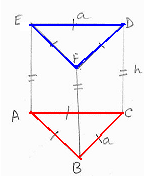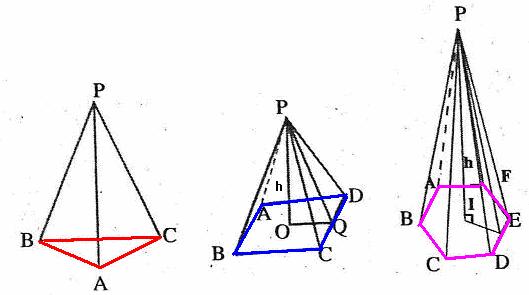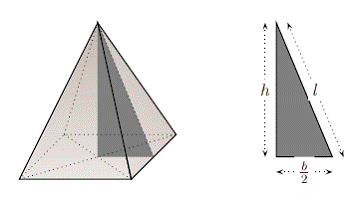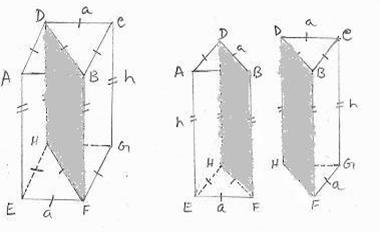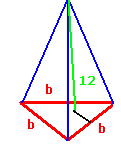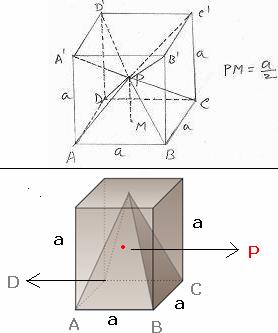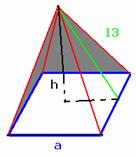6.10 Geometric Solid Figures:
6.10.1 Properties of solid
figures
In science you have learnt differences between
solids, liquids and gasses. You also know to draw some geometrical figures
(polygons) on
a plane (called 2 dimensional). Geometrical
figures which are solids in shape are cuboids, cube, cylinder, cone, sphere,
etc.
Differences between planes and solid figures are:
|
No |
Plane figures |
Solid figures |
|
1 |
They
only have areas |
They
occupy space and hence have volume |
|
2 |
Measured
by length and breadth |
Measured
by length and breadth and height |
|
3 |
They
are formed by a minimum of 3 Coplanar (on same plane) points |
They
are formed by a minimum of 4 points on different planes |
Properties of Cuboids:
|
1.
They have eight vertices (A,B,C,D,E,F,G,H) 2.
They have six faces [bottom (EFGH), top(ABCD) and 4 sides(ABFE,BCGF,DCGH,ADHE) 3.
All sides are rectangular in shape 4.
They are formed by 12 line segments (edges) Four
vertical sides of cuboids are called ‘lateral
surfaces’(ABFE,BCGF,DCGH,ADHE) and the other two are called ‘base’(EFGH) and ‘top’(ABCD). The
lateral surface area of the cuboid = Area of ABFE +
Area BCGF, Area of DCGH + area of ADHE = lh+bh+lh+bh =
2h(l+b) |
|
Have you seen houses, office buildings, memorials
and other constructions in shapes other than Quadrilaterals? You must have
thought how
they calculate the areas of
these constructions, for buying paints and other materials. Similarly people
construct water tanks in shapes other
than cuboids for various
reasons. Is it not necessary for us to calculate the volume of these solids to
know the capacity of these tanks?
Here we will be studying few such solid figures.
Since cuboids have rectangle as bases, let us look
at other types of solids whose bases are polygons (triangle, pentagon and hexagon).
Such figures are called ‘Prisms’.
|
‘Prism’ can be defined as a closed solid figure with
rectangular lateral surfaces And with parallel and
congruent (matching in all aspects) polygons as base and top. Properties
of prisms are: 1.
All the lateral surfaces are rectangular 2.
Base and top are of same shape and size The line where two lateral surfaces intersect
is called ‘edge’ Depending
on the type of the
base of the prism we have ‘Triangular prism’,
‘Rectangular prism’, ‘Pentagonal prism’, ‘Hexagonal prism’, etc… |
|
What if the prisms do not stand straight on a
plane? Let us look at the figures drawn below.
In the first figure, base plane and top plane are
perpendicular to each other and the height of this prism is the edge. In the
second figure,
base plane and top plane
are parallel but the edges are not perpendicular to the base or top. That is
why we cannot directly measure the
height but we can measure the
slanted height.
|
No |
Right Prism |
Right Prism No |
Oblique Prism |
Oblique Prism |
|
1 |
|
The
edges of the base are perpendicular to the plane of the base |
The
edges of the base are not perpendicular to the plane of the base |
|
|
2 |
The
lateral surfaces are rectangles |
The
lateral surfaces are parallelograms |
||
|
3 |
The
edge is height of the prism |
The
edge cannot be taken as the height of the prism as it is not is not vertical |
6.10.2 Surface Area of
Prisms
Let the Prism ABCDEF be a triangular prism with
equilateral triangle as the base.
Observe the following:
|
1.
The base ABC and top DEF are equilateral triangles with sides ‘a’ 2.
3.
The lateral edges AE, BF and CD are parallel and are of equal height ‘h’ 4.
The 3 lateral surfaces are ABFE, BCDF and ACDE. Area of each surface = a*h=ah Since
this prism has 3 lateral surfaces, lateral surface area = 3ah. Total
Surface Area (TSA) of the prism = area of base + area of top + area of
lateral surfaces =
2*(area of base) + 3ah (because area of base = area of top) Perimeter
of the base (P) is 3a (sum of 3 sides of the equilateral triangle). Thus
TSA = 2*area of the base of prism + (perimeter of the base)*height = 2B+Ph Where
,B = Area of the base of the prism ,P = Perimeter of the base of the prism |
|
The above formula for Total Surface Area is
applicable to any right prism.
6.10.2 Problem 1: Find the altitude of right prism whose lateral
surface is 143sqcm and perimeter of the base (P) is 13cm.
Solution:
We know that the formula for lateral surface area =
Ph
![]() 143 = 13h and hence h = 11cm.
143 = 13h and hence h = 11cm.
6.10.2 Problem 2: The base of a square based
prism has edge equal to 2cm and height 12cm.
A hole extending from top
to base is in the shape of an equilateral triangular prism with an edge
of length 1cm. Find out the total surface area of the solid
(exterior painting area of the prism).
Solution:
|
Method: First
we need to calculate the TSA of the solid without the hole. From
this TSA we need to subtract the area (both base and top) of the hole, to get
the area of painting. Since
the prism is a square prism of side 2cm; the area of the base = 4sqcm
Perimeter of the base (P) is 8cm Total
Surface Area (without considering the hole) = 2B + Ph =8+96=104sqcm The
hole is of the shape of an equilateral triangle of side 1cm and hence the
area of the base/top = (12
* Therefore
TSA after considering the hole = TSA of the solid without the hole – area of
the base of the hole – area of the top of the hole = 104 - |
|
|
Note: We have used the following formula to calculate the area of an equilateral
triangle. Area
of triangle = bh/2 (where b is the base of the triangle and h is the height
of the triangle) In
the case of an equilateral triangle, h = b*( Therefore
Area of an equilateral triangle = (b2* |
|
6.10.3 Pyramids
We called a solid, with polygons as base and top
and with rectangle as lateral surfaces, a Prism. What if we have a solid figure
without a top
but with its sides converging at a
point?
|
Definition: A pyramid is a solid
figure with polygonal base and triangular sides (lateral surfaces) converging
at a point. The
converging point is called ‘vertex’. Since
sides of a pyramid converge at a point, pyramids do not have top surface. Depending
on the type of polygonal base of the pyramid, we classify pyramids as ‘Triangular pyramid’, ‘Rectangular
pyramid’ and ‘Hexagonal pyramid’ as shown
in the figures on
right hand side. In the adjacent figures, P is the vertex and ABC, ABCD, ABCDEF are base of the pyramids. |
|
The relationship between base,
height and slant height in a square pyramid:
|
Let the side of base of pyramid =b Let the height of the pyramid =h Let the slant height of the pyramid =l Then by Pythagoras theorem l2= (b/2)2+ h2
|
|
Surface
area of a pyramid
|
PABCD
is a square pyramid. ABCD is the base and it is a square. Q is the midpoint
of ABCD. PQ is the height (h) and N is the mid point of the edge BC. PN is
the slant height (l). AB=BC=CD=DA=a PAB, PBC, PCD and PAD are the 4
lateral surfaces which are congruent isosceles triangles. Perimeter of the base (p) =
4*length of base 1. Lateral surface area of the square pyramid PABCDP: = sum of the areas of 4
congruent lateral surfaces (PAB, PBC, PCD, PAD) = 4*(area of one triangle) = 4(1/2) base*slant height)) = 4al/2 = 2al = (1/2)(perimeter
of base)*(slant height) Total
Surface Area (TSA) of square based pyramid = Area of the base + Lateral
surface area = a2+ 1/2 (pl) |
|
2. Surface area of a regular triangular
pyramid PABC:
|
ABC
is an equilateral triangle (AB=BC=CA=a). Let
N be the mid point of the side BC and hence PN is the slant height (l). PAB,
PBC and PCA are 3 lateral surfaces which are congruent isosceles triangles. Perimeter
of the base (p) = 3*length of base The
lateral surface area of a regular triangular pyramid = sum of the areas of 3 congruent
lateral surfaces (PAB, PBC,PCA) = 3*(area of one triangle) = 3(½ base*slant height) = 1/2 (3al) = 1/2 (Perimeter of
base)*(slant height)= 1/2
(Pl) Total
Surface Area (TSA) of a regular triangular pyramid = Area of the base + Lateral
surface area = B+ 1/2 (Pl) Since
base is an equilateral triangle, B = (a2 |
|
6.10.3 Problem 1: A pyramidal tent with a square base of side 5m and
slant height of 4m is put up for a function and is covered by a canvas.
If the rent for usage of tent is paid based on the
area of canvas, find out the area of canvas.
Solution:
|
Here
P = 4*5
m=20m l = 4 m Lateral
surface area = ½(Pl) = ½(20*4) = 40sqmts |
|
6.10.3 Problem 2: Total surface area of a square based pyramid is
125sqcms and the perimeter of the base is 20cm. find the area of the
base and slant height
Solution:
|
Given:
Perimeter {p=4a} of the square is 20cm. Hence
the side (a) is 5cm. Area
of the base (B=a2) = 25sqcm Since
TSA = Area of the base +½(Pl). On
substitution we get 125
= 25+½(Pl): 125=25+½(20*l): 125 = 25+10*l 10*l
= 125-25 =100 (transposition) Thus
the slant height (l) = 10cm |
|
6.10.4 Volume of Prisms
and pyramids
|
We
know that the volume of a cuboid =
length*breadth*height. We
also know that (length*breadth) gives the area of the base of the cuboid. So,
Volume of cuboid = (Area of
base) * height |
|
Volume of a ‘triangular right
prism’
|
We
can think 2nd figure as 2 equal parts of the first figure cut in
the middle. Hence
the volume of square based prism is twice the volume of triangular based right prism. We also notice that the square base
is made up of two identical isosceles triangles. Volume
of a triangular right prism =
1/2 (Volume of square based prism) =
1/2 (‘base area of square based prism’*height) =
1/2 (2*‘area of triangular base’*height) =
the area of triangular base’*height |
|
In general, volume of a prism is equal to the product of the area
of its base and its height.
6.10.4 Problem 1: The volume of a regular triangular based prism is
27![]() cc and its height is 12cm. Find the length of side of the
base.
cc and its height is 12cm. Find the length of side of the
base.
Solution:
|
Let
‘b’ be the length of side of the base. We know that the area of equilateral
triangle = (b2 As
per the formula:Volume of the
prism = ‘base area’ * height = (b2 On
substituting values we have 27 27
= 12 *b2/4 3
b2=27 : |
|
Volume of a pyramid
|
Let
ABCD be the square base (of side ‘a’ units) of a pyramid PABCD with P as
vertex. From
P, drop a perpendicular to the base to meet the base at M. From
the figure it can be seen that PM = h = a/2.
From
the cube(refer to adjacent figure) PABCD, we
can totally make 6 congruent( identical) pyramids PABCD,
PBCC1B1, PCC1D1D, PC1D1A1B1,
PD1A1AD and PABB1A1. (Each
of these pyramid’s base corresponds to each face of the cube. We
can say that when these 6 pyramids are joined, we will have a square based
pyramid.) As
can also be visualized from the figure on the right hand side Volume
of square based pyramid = 1/6(volume of cube) = 1/6{(Area of base) * a} = 1/6{(Area of base) * 2h} ( = 1/3{(Area of base) * h} = 1/3 (Bh); where
B is area of the base = 1/3 volume of square prism of same base
and height. |
|
Similarly we can prove that volume of a triangular pyramid
is one third the volume of prism.
In general, volume of a pyramid is equal to one third the product
of its base area and its height.
6.10.4 Problem 2: A tent of pyramidal
shape is made out of canvas. It occupies a square area of 100sqmts on the
ground and the
slant height of the pyramid
is 13mts. Calculate the air space inside the tent. (To get the actual height
(h) of the tent,
use the formula h2= l2-(a/2)2 where l is the slant height and a is the length
of base )
Solution:
|
Since
base area is 100sqmts, a=10m; l is given to be 13
m. We need the vertical height of the tent to calculate air space. We are given
h2 = l2-(a/2)2; on
substitution we have h2
= 169-25 = 144 Air
space inside the tent = Volume of the tent = 1/3Bh = 1/3(100*12) = 400cu.mts |
|
6.10.4 Problem 3: A farm has a water tank of dimensions (l=4m, b=1.2m
and h=1m) for cows to drink water and is filled with water once
in the morning. If a cow consumes 40lts
of water in a day, find out how many cows would be able to drink water on a
given day
(note 1cu.mts = 1000Litres
(lts))
Solution:
Volume of tank = 4*1.2*1cu.mts = 4.8cu.mts =
4800Litres ( ![]() 1cu.mts = 1000Litres)
1cu.mts = 1000Litres)
Number of cows that can drink water = 4800/40 = 120
cows
6.10.4 Problem 4: Find the height of a pyramid whose volume is 900cu.mts
and base is a rectangle of sides 20m and 15m.
Solution:
|
We
know that volume of a pyramid = 1/3 (Bh) (where B
is the area of base and h is the height) On
substituting values for volume and B, we have 900
= 1/3(20*15)h; 900 = 100h; h =9m Thus
the height of the pyramid is 9m. |
|
6.10.4 Problem 5: A brick’s length, breadth and height is 18,12 and 3
inches respectively. A wall’s length,width
and height is 8,5 and 3
‘Hastas’ (A measuring unit). Find the volume of the
wall, the number of bricks in the wall and the number of rows of bricks in
the wall (Lilavati Shloka 227)
( 1 Hasta = 24 inches)
|
|
6.10 Summary of
learning
|
No |
Points to remember |
|
1 |
Total
surface area of a cuboid is 2(lb+bh+lh) and its lateral surface area = 2(bh+lh) |
|
2 |
Prism
is a closed solid figure with
rectangular lateral surfaces and with parallel and congruent polygons as base
and top. |
|
3 |
Total
Surface Area of a Right Prism = 2*area of the base of prism + (perimeter of
the base) * height |
|
4 |
A
pyramid is a solid figure with polygonal base and triangular sides (lateral
surfaces) converging at a point. The converging point is called ‘vertex’. |
|
5 |
Total
Surface Area of square based pyramid = Area of the base + Lateral surface
area= a2+ 1/2(pl) where p is perimeter of the base and l is the
slant height |
|
6 |
Total
Surface Area of regular triangular
pyramid = Area of the base + Lateral surface area= B+ 1/2(Pl) where P is
perimeter of the base and l is the slant height |
|
7 |
Volume
of a cuboid is equal to the product of its length, breadth, and height |
|
8 |
Volume
of a prism is equal to the product of its base area and its height. |
|
9 |
Volume
of a pyramid is equal to one third the product of its base area and its
height. |




